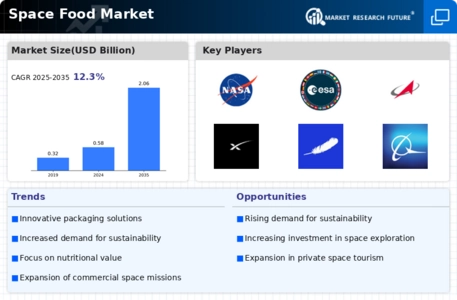Market Growth Projections
The Global Space Food Market Industry is poised for substantial growth, with projections indicating a market value of 2.06 USD Billion by 2035. This growth trajectory reflects a compound annual growth rate of 12.3% from 2025 to 2035, driven by various factors including increased space exploration activities and advancements in food technology. The market's expansion is indicative of the increasing recognition of the importance of nutrition in space missions, as well as the need for innovative food solutions that cater to the unique challenges of space travel. Such projections highlight the dynamic nature of the industry and its potential for future development.
Health and Nutrition Awareness
The Global Space Food Market Industry is increasingly influenced by the growing awareness of health and nutrition among space agencies and astronauts. As missions extend in duration, the nutritional requirements of astronauts become more complex. This awareness drives the development of space food that not only meets caloric needs but also provides essential vitamins and minerals. The emphasis on healthful eating habits is likely to shape product offerings, ensuring that astronauts maintain optimal health during missions. This focus on nutrition aligns with the anticipated compound annual growth rate of 12.3% for the period from 2025 to 2035, reflecting a shift towards more health-conscious space food solutions.
Emerging Private Sector Participation
The emergence of private sector participation in space exploration significantly influences the Global Space Food Market Industry. Companies like SpaceX and Blue Origin are not only advancing space travel but are also exploring the logistics of food supply for their missions. This involvement introduces competition and innovation in the space food sector, potentially leading to new products and services tailored for astronauts. As private companies continue to invest in space missions, the demand for specialized food products is likely to rise, further propelling the market towards its projected growth of 0.58 USD Billion in 2024.
Increasing Demand for Space Exploration
The Global Space Food Market Industry experiences a notable surge in demand driven by the increasing interest in space exploration. As nations and private entities invest in missions to the Moon, Mars, and beyond, the need for specialized food products tailored for long-duration space travel becomes paramount. This trend is underscored by the projected market value of 0.58 USD Billion in 2024, which is anticipated to grow significantly as more missions are planned. The development of food that can withstand the rigors of space travel while providing essential nutrients is critical, thus propelling the Global Space Food Market Industry forward.
Technological Advancements in Food Preservation
Technological innovations play a crucial role in shaping the Global Space Food Market Industry. Advances in food preservation techniques, such as freeze-drying and vacuum sealing, enhance the shelf life and nutritional quality of space food. These methods not only ensure that food remains safe for consumption during extended missions but also retain flavor and texture, which are vital for astronaut morale. As the market evolves, these technologies are likely to improve, leading to a more diverse range of food options. This evolution is essential as the industry prepares for the projected growth to 2.06 USD Billion by 2035, indicating a robust future.
Collaboration Between Space Agencies and Food Scientists
Collaboration between space agencies and food scientists is a pivotal driver of the Global Space Food Market Industry. These partnerships facilitate the exchange of knowledge and expertise, leading to the development of innovative food products specifically designed for space conditions. For instance, NASA's collaboration with universities and research institutions has resulted in the creation of new food technologies that enhance the quality and safety of space food. Such collaborations are essential as they not only improve food options for astronauts but also contribute to the overall growth of the market, which is projected to reach 2.06 USD Billion by 2035.





















